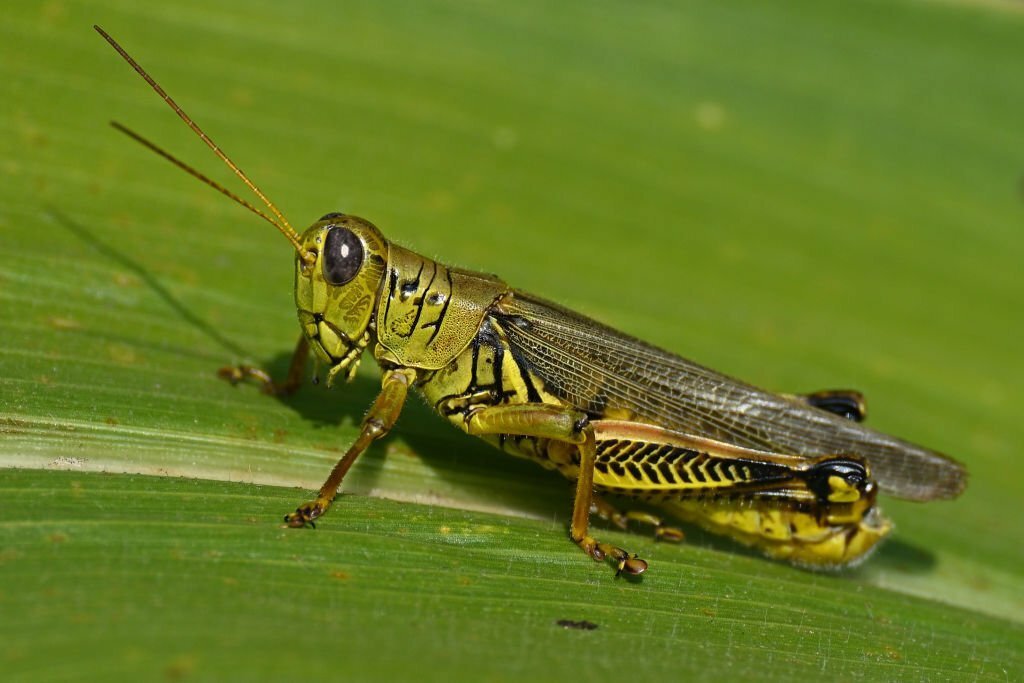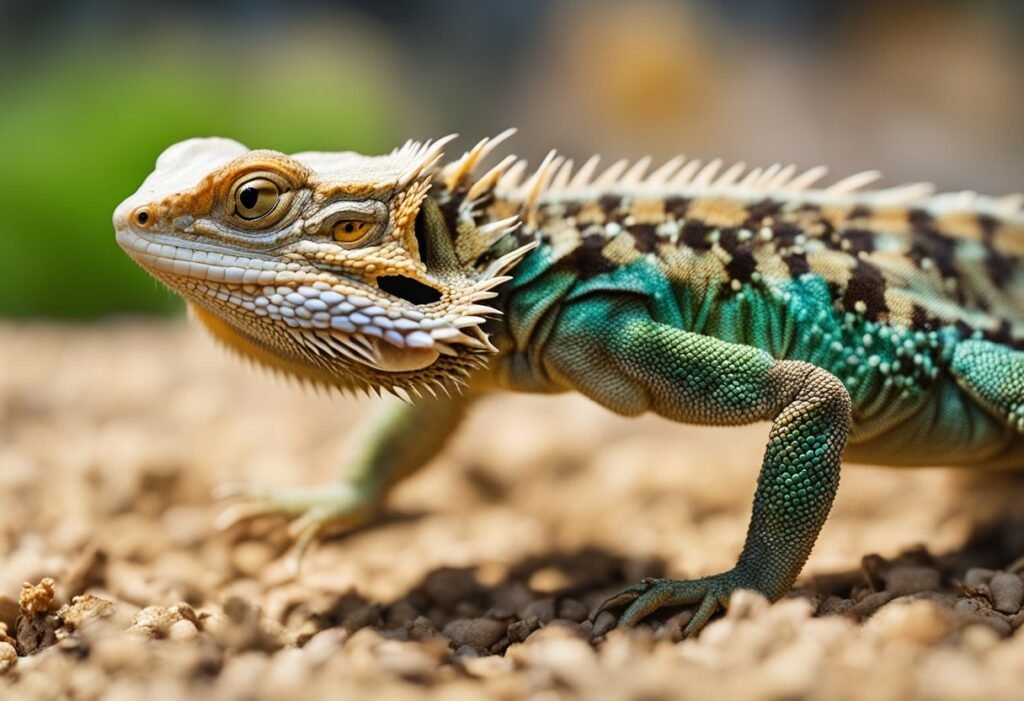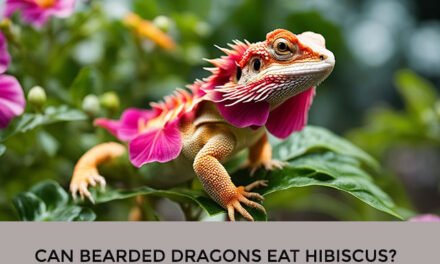Bearded dragons are popular pets due to their docile nature and unique appearance. As omnivores, they require a varied diet that includes both insects and vegetables. One common question that arises among bearded dragon owners is whether they can eat locusts.
Locusts are a type of grasshopper that are often used as a food source for reptiles. They are high in protein and other essential nutrients, making them a good option for bearded dragons. However, it is important to ensure that the locusts are appropriate for your pet and that they are fed in moderation.
In this article, we will explore whether bearded dragons can eat locusts and provide guidance on feeding them to your pet. We will discuss the nutritional benefits of locusts, potential risks associated with feeding them, and how to incorporate them into your bearded dragon’s diet.
Can Bearded Dragons Eat Locusts?

We often get asked if bearded dragons can eat locusts. The answer is yes, they can! In fact, locusts are a great addition to a bearded dragon’s diet.
Locusts are high in protein, which is essential for a bearded dragon’s growth and development. They also contain important vitamins and minerals, such as calcium, which helps to keep a bearded dragon’s bones healthy.
When feeding your bearded dragon locusts, it’s important to make sure they are the right size. You don’t want to feed your bearded dragon anything too big or too small, as this can be dangerous.
We recommend feeding your bearded dragon locusts that are no larger than the space between their eyes. This will ensure that the locusts are a safe size for your bearded dragon to eat.
It’s also important to make sure the locusts are gut-loaded. This means feeding them a nutritious diet before feeding them to your bearded dragon. This will ensure that your bearded dragon is getting all the nutrients they need from the locusts.
In conclusion, bearded dragons can eat locusts and they are a great addition to their diet. Just make sure the locusts are the right size and gut-loaded before feeding them to your bearded dragon.
Understanding Bearded Dragon Diet

Bearded dragons are omnivorous reptiles that require a balanced diet to maintain good health. Their diet should consist of a variety of insects, vegetables, and fruits. Insects should make up the majority of their diet, with vegetables and fruits being offered in smaller amounts.
When it comes to selecting insects for your bearded dragon, it’s important to choose ones that are appropriate in size and nutritional content. Some common insects that are safe for bearded dragons to eat include crickets, mealworms, and dubia roaches. However, can bearded dragons eat locusts?
Yes, bearded dragons can eat locusts. In fact, locusts are a great addition to their diet as they are high in protein and low in fat. However, it’s important to ensure that the locusts are the appropriate size for your bearded dragon. If the locusts are too large, they can cause choking or digestive issues.
It’s also important to ensure that the locusts are gut-loaded before being fed to your bearded dragon. This means that the locusts should be fed a nutritious diet for at least 24 hours before being offered to your bearded dragon. This ensures that your bearded dragon is getting the maximum nutritional benefit from the locusts.
In conclusion, bearded dragons can eat locusts as part of a balanced diet. Just make sure that the locusts are the appropriate size and gut-loaded before being offered to your bearded dragon.
Locusts in a Bearded Dragon’s Diet

When it comes to feeding bearded dragons, it can be challenging to find a food source that is both nutritious and enjoyable for them to eat. One option that many bearded dragon owners consider is feeding them locusts. In this section, we will discuss the nutritional value of locusts and how often they should be fed to your bearded dragon.
Nutritional Value of Locusts
Locusts are a great source of protein, which is essential for the growth and maintenance of bearded dragons. They also contain a variety of vitamins and minerals that are important for their health, including calcium, phosphorus, and iron. However, it is important to note that the nutritional value of locusts can vary depending on their age and size. Younger and smaller locusts tend to have a higher protein content, while larger and older locusts have a higher fat content.
Feeding Frequency
When it comes to feeding locusts to your bearded dragon, it is important to consider their size and age. Younger bearded dragons require more frequent feedings, while older bearded dragons can be fed less often. As a general rule of thumb, bearded dragons should be fed a diet that is 80% vegetables and 20% protein. This means that locusts should not make up the majority of their diet, but can be fed as a supplement.
The frequency of feeding locusts to your bearded dragon will depend on their age and size. Younger bearded dragons should be fed smaller locusts more frequently, while older bearded dragons can be fed larger locusts less often. A good rule of thumb is to feed your bearded dragon 2-3 appropriately sized locusts per feeding, 2-3 times per week.
In conclusion, locusts can be a great addition to your bearded dragon’s diet, as they provide a good source of protein and other essential nutrients. However, it is important to feed them in moderation and to consider their age and size when determining how often to feed them.
Potential Risks of Feeding Locusts to Bearded Dragons

When it comes to feeding bearded dragons, locusts are a popular choice among owners. However, there are potential risks associated with feeding these insects to your pet.
Overfeeding
Overfeeding is a common issue among bearded dragon owners, and feeding too many locusts can lead to obesity and other health problems. It’s important to monitor your pet’s diet and ensure they are receiving a balanced and varied diet.
Insecticide Contamination
Another potential risk of feeding locusts to bearded dragons is insecticide contamination. Locusts can be exposed to insecticides and other harmful chemicals in the environment, which can then be passed on to your pet. It’s important to source locusts from a reputable supplier and avoid feeding wild-caught insects.
In conclusion, while locusts can be a nutritious food source for bearded dragons, it’s important to be aware of the potential risks associated with feeding them. By monitoring your pet’s diet and sourcing insects from a reputable supplier, you can help ensure your pet stays healthy and happy.
Alternatives to Locusts for Bearded Dragons
If you’re looking for a variety of food options for your bearded dragon, there are plenty of alternatives to locusts that you can consider. Here are a few options:
Crickets
Crickets are a popular alternative to locusts as they are high in protein and easy to find. They are also a good source of calcium and other essential nutrients. However, it is important to note that crickets can be carriers of parasites and diseases, so it is important to buy them from a reputable source and dust them with calcium and vitamin supplements before feeding them to your bearded dragon.
Mealworms
Mealworms are another alternative to locusts that are high in protein and easy to find. They are also a good source of calcium and other essential nutrients. However, mealworms have a hard exoskeleton that can be difficult for bearded dragons to digest, so it is important to only feed them in moderation.
Fruits and Vegetables
In addition to insects, bearded dragons also enjoy eating fruits and vegetables. Some good options include leafy greens like kale and collard greens, as well as fruits like strawberries and blueberries. These foods are a good source of vitamins and minerals, and can also help keep your bearded dragon hydrated.
Overall, there are plenty of alternatives to locusts that you can consider when feeding your bearded dragon. Just make sure to do your research and provide a balanced diet that meets all of their nutritional needs.
Conclusion
In conclusion, bearded dragons can eat locusts as part of a balanced diet. However, it’s important to note that they should not be the sole source of food. Variety is key when it comes to feeding bearded dragons, and a diet consisting solely of locusts can lead to nutritional deficiencies.
When feeding locusts to bearded dragons, it’s important to ensure that they are properly gut-loaded and dusted with calcium and vitamin supplements. This will ensure that the bearded dragon is receiving the necessary nutrients for optimal health.
Additionally, it’s important to monitor the size of the locusts being fed to the bearded dragon. Too large of a locust can cause choking or impaction, while too small of a locust may not provide enough nutrition.
Overall, when fed in moderation and as part of a varied diet, locusts can be a healthy and nutritious food source for bearded dragons.
Frequently Asked Questions

What is the recommended feeding schedule for bearded dragons and locusts?
We recommend feeding adult bearded dragons once a day, while juveniles should be fed twice a day. As for locusts, they can be fed to bearded dragons every other day.
Can adult locusts be fed to bearded dragons?
Yes, adult locusts can be fed to bearded dragons. However, it’s important to note that adult locusts have a harder exoskeleton that may be difficult for younger or smaller bearded dragons to digest.
Are freeze-dried locusts a good food option for bearded dragons?
While freeze-dried locusts may seem like a convenient option, they lack the nutritional value of live or fresh locusts. We recommend feeding live or fresh locusts to ensure your bearded dragon is getting the necessary nutrients.
How do I encourage my bearded dragon to eat locusts?
Some bearded dragons may be hesitant to try new foods, including locusts. Try offering them in small quantities and alongside their favorite foods. You can also try hand-feeding to encourage them to try locusts.
What is the ideal age for a bearded dragon to start eating locusts?
Bearded dragons can start eating locusts at around 4-6 months old. However, it’s important to introduce them gradually and monitor their digestion to ensure they’re able to handle the new food.
Can locusts be a part of a balanced diet for baby bearded dragons?
Locusts can be a part of a balanced diet for baby bearded dragons, but it’s important to ensure they’re getting a variety of other foods as well. Baby bearded dragons require more protein than adults, so feeding them more insects is recommended.





